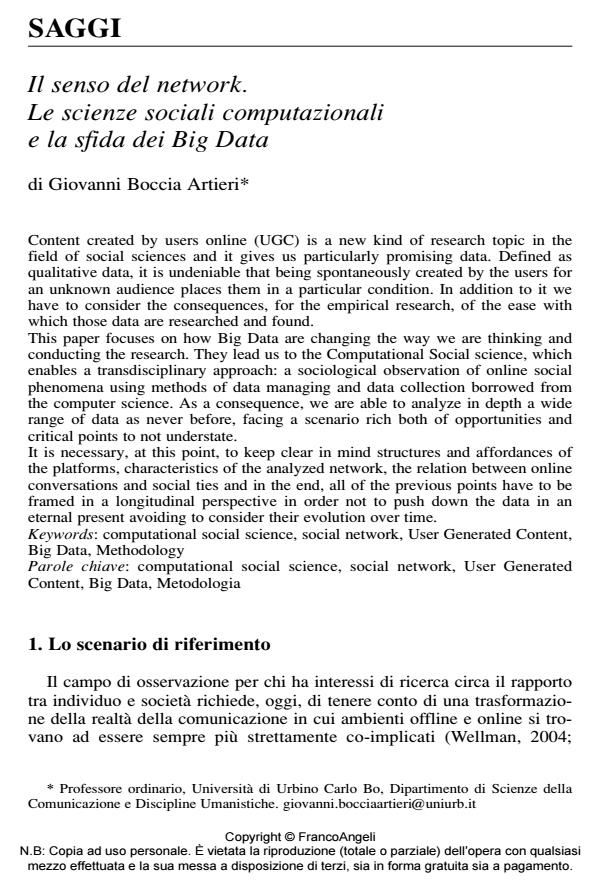Il senso del network. Le scienze sociali computazionali e la sfida dei Big Data
Titolo Rivista SALUTE E SOCIETÀ
Autori/Curatori Giovanni Boccia Artieri
Anno di pubblicazione 2014 Fascicolo 2014/3
Lingua Italiano Numero pagine 14 P. 25-38 Dimensione file 518 KB
DOI 10.3280/SES2014-003003
Il DOI è il codice a barre della proprietà intellettuale: per saperne di più
clicca qui
Qui sotto puoi vedere in anteprima la prima pagina di questo articolo.
Se questo articolo ti interessa, lo puoi acquistare (e scaricare in formato pdf) seguendo le facili indicazioni per acquistare il download credit. Acquista Download Credits per scaricare questo Articolo in formato PDF

FrancoAngeli è membro della Publishers International Linking Association, Inc (PILA)associazione indipendente e non profit per facilitare (attraverso i servizi tecnologici implementati da CrossRef.org) l’accesso degli studiosi ai contenuti digitali nelle pubblicazioni professionali e scientifiche
Content created by users online (UGC) is a new kind of research topic in the field of social sciences and it gives us particularly promising data. Defined as qualitative data, it is undeniable that being spontaneously created by the users for an unknown audience places them in a particular condition. In addition to it we have to consider the consequences, for the empirical research, of the ease with which those data are researched and found. This paper focuses on how Big Data are changing the way we are thinking and conducting the research. They lead us to the Computational Social science, which enables a transdisciplinary approach: a sociological observation of online social phenomena using methods of data managing and data collection borrowed from the computer science. As a consequence, we are able to analyze in depth a wide range of data as never before, facing a scenario rich both of opportunities and critical points to not understate. It is necessary, at this point, to keep clear in mind structures and affordances of the platforms, characteristics of the analyzed network, the relation between online conversations and social ties and in the end, all of the previous points have to be framed in a longitudinal perspective in order not to push down the data in an eternal present avoiding to consider their evolution over time.
Parole chiave:Computational social science, social network, User Generated Content, Big Data, Metodologia
- Immagini per il presente. L'evento catastrofico nei Twitter online (visual) data Giovanni Boccia Artieri, Laura Gemini, Manolo Farci, Elisabetta Zurovac, in SOCIOLOGIA DELLA COMUNICAZIONE 49/2015 pp.55
DOI: 10.3280/SC2015-049005
Giovanni Boccia Artieri, Il senso del network. Le scienze sociali computazionali e la sfida dei Big Data in "SALUTE E SOCIETÀ" 3/2014, pp 25-38, DOI: 10.3280/SES2014-003003